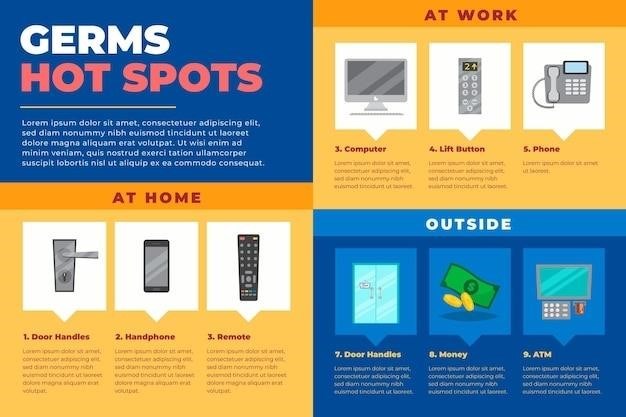
Manual Control Remoto Aire Acondicionado⁚ Una Guía Completa
This comprehensive guide covers all aspects of your air conditioning remote, from basic functions like temperature and fan speed control to advanced features such as timers and sleep modes. Troubleshooting tips and safety considerations are also included for optimal performance and peace of mind. Enjoy a comfortably cool home!
Introducción al Control Remoto
Your air conditioner’s remote control is your primary interface for managing its functions. Understanding its operation is crucial for comfortable climate control. This small device allows you to conveniently adjust settings without physically interacting with the air conditioning unit itself. From turning the unit on or off to selecting cooling, heating, or fan modes, the remote provides effortless control. Many models incorporate additional features like programmable timers, sleep modes, and even swing functions to direct airflow; Familiarizing yourself with the remote’s buttons and symbols will empower you to maximize your air conditioner’s capabilities and create the ideal indoor environment. Before using your air conditioner, carefully review your remote’s instructions to unlock all its features and ensure proper usage. This will optimize your comfort and extend the life of your appliance. Consult your user manual for specific details regarding your model’s remote control functionalities and troubleshooting. Remember to always keep the remote in a safe and accessible location to easily manage your air conditioning needs. Proper usage of your remote control will enhance your overall experience with your air conditioning system.
Tipos de Controles Remotos⁚ Universal vs. Específico
Air conditioner remotes fall into two main categories⁚ universal and specific. A specific remote is designed to work only with a particular brand and model of air conditioner. It offers precise control over all features, often with intuitive button layouts tailored to the unit’s capabilities. These remotes are generally included with the air conditioner upon purchase. In contrast, a universal remote is designed for broader compatibility, often working with multiple brands and models. This flexibility makes them valuable if you replace your air conditioner or if your original remote malfunctions. However, universal remotes may not offer access to every feature of your specific air conditioning unit, and programming can sometimes be more complex. The choice depends on your needs and preferences. Specific remotes provide optimized control, while universal remotes offer greater flexibility. Consider whether the convenience of a dedicated remote outweighs the broader compatibility of a universal one before making your selection. Always check compatibility before purchasing a universal remote to ensure it works with your air conditioner model.
Funciones Básicas del Control Remoto

The fundamental functions of an air conditioner remote control center around managing the unit’s core operations. At the most basic level, you’ll find buttons to power the unit on and off, a crucial first step in controlling your indoor climate. Temperature adjustment is another key function, allowing you to set your desired comfort level. Most remotes use numerical buttons or up/down arrows for precise temperature selection. Fan speed control is equally important, offering options to tailor airflow to your preferences. Low speed settings provide gentle breezes, while higher speeds offer more powerful cooling. Many remotes include a “Mode” button, which is crucial for selecting the operating mode of your air conditioner. Typical modes include cooling, heating (if applicable), fan-only, and potentially auto mode, allowing the unit to automatically adjust settings based on the current temperature. These basic controls provide the foundation for managing your air conditioner’s performance and optimizing your home’s comfort. Mastering these essential functions will allow you to quickly adjust your environment to suit your needs.
Modos de Operación⁚ Enfriamiento, Calefacción, Ventilación
Understanding the operational modes of your air conditioner’s remote is vital for maximizing its effectiveness and energy efficiency. The most common mode is “Cooling,” which activates the unit’s refrigerant system to lower the room temperature. This is the go-to setting during hot weather. Many units also offer a “Heating” mode, usually found in heat pumps or units with both cooling and heating capabilities. In this mode, the unit works in reverse, extracting heat from the outside air to warm your interior space. This is particularly helpful during colder months. The “Fan” or “Ventilation” mode operates the fan without engaging the cooling or heating functions. This setting circulates existing air, useful for gentle air movement without significant temperature changes. It’s ideal for times when you want air circulation but not active cooling or heating. Some advanced units may offer an “Auto” mode, which automatically selects the appropriate cooling or heating mode based on the set temperature and ambient conditions. Selecting the correct mode ensures that your air conditioner operates efficiently and effectively, providing optimal comfort while consuming the least amount of energy.
Configuración de Temperatura y Velocidad del Ventilador
Precise temperature control is a key feature of modern air conditioning systems. Your remote typically allows you to set the desired temperature in degrees Celsius or Fahrenheit, depending on your unit’s settings. Adjusting this value dictates the cooling or heating level. Lower settings will result in more aggressive cooling or heating, while higher settings will lead to a more moderate approach. Remember that setting the temperature too low won’t necessarily cool the room faster; it might simply lead to increased energy consumption without significant improvement in cooling time. Fan speed control complements temperature adjustment. Most remotes offer several fan speed options, ranging from low to high. A lower fan speed provides gentle air circulation, ideal for quiet operation or when only minor temperature adjustments are needed. Higher fan speeds offer more powerful air circulation, achieving faster temperature changes. The optimal fan speed will depend on your comfort preferences and the size of the room. Experiment to find the best balance between cooling efficiency and noise level. Keep in mind that excessively high fan speeds might lead to increased noise and potentially higher energy usage, without a proportional increase in cooling efficiency. Finding the right combination of temperature and fan speed is key to maximizing comfort and energy efficiency.
Funciones Adicionales⁚ Temporizador, Modo Sueño, etc.
Many modern air conditioner remotes offer advanced features beyond basic temperature and fan control. A timer function allows you to schedule the unit to turn on or off automatically at specific times, providing convenient control over cooling or heating. This is particularly useful for pre-cooling or pre-heating a room before you arrive, or for automatically shutting down the unit during unoccupied periods to save energy. The sleep mode, often denoted by a crescent moon icon, is designed to enhance comfort and energy efficiency during sleep. It typically involves gradually increasing the temperature setting over a period of time, preventing sudden temperature shifts that might disrupt sleep. Some remotes also include a “swing” or “air direction” function, enabling you to control the vertical or horizontal direction of airflow. This lets you customize the airflow to suit your preferences and optimize the distribution of cool or warm air throughout the room. Other potential features may include a “turbo” or “powerful cooling” mode for rapid temperature adjustment, and an “auto” mode that automatically adjusts settings based on ambient conditions. Always refer to your specific remote’s manual for a complete description of its functionalities and how to utilize them effectively. These extra features significantly improve the user experience and allow for greater control and energy efficiency.
Solución de Problemas Comunes
If your air conditioner remote isn’t working correctly, several troubleshooting steps can help pinpoint the issue. First, check the batteries in the remote; weak or depleted batteries are a common cause of malfunction. Ensure the batteries are correctly installed and replace them if necessary. Next, verify that the remote is properly aimed at the indoor unit’s receiver. Obstructions like curtains, furniture, or other objects can interfere with the signal transmission. Try removing any potential barriers and aiming directly at the receiver. Also, check the distance between the remote and the indoor unit; the range of the signal might be limited. If the problem persists, examine the indoor unit itself. Make sure it’s properly powered and that the power cord is securely connected. Check for any error codes displayed on the unit’s control panel, as these often indicate specific issues. Consult your air conditioner’s user manual for guidance on interpreting error codes and troubleshooting associated problems. If the indoor unit seems to be functioning correctly and the remote continues to malfunction, the remote control itself may need to be replaced. In some cases, the receiver in the indoor unit might be faulty, requiring professional service. Remember to always consult a qualified technician for any repairs or maintenance beyond basic troubleshooting steps.
Mantenimiento del Control Remoto
Regular maintenance of your air conditioning remote control ensures optimal performance and extends its lifespan. Begin by cleaning the remote regularly. Use a soft, slightly damp cloth to gently wipe away dust, dirt, and fingerprints from the surface. Avoid using harsh chemicals or abrasive cleaners, as these can damage the remote’s casing or buttons. Pay particular attention to the button area, as these are prone to accumulating grime. For stubborn stains, a mild soap solution can be used, but ensure the remote is thoroughly dried afterward to prevent damage from moisture. Periodically inspect the battery compartment for any corrosion or debris. Clean the compartment with a dry cloth or cotton swab to remove any buildup. If corrosion is present, carefully clean it using a cotton swab dipped in rubbing alcohol. Allow the compartment to dry completely before reinstalling the batteries. Store the remote in a cool, dry place away from direct sunlight or extreme temperatures. Avoid dropping or exposing it to excessive moisture, as this can damage internal components. If the remote shows signs of significant wear and tear, such as cracked casing or unresponsive buttons, consider replacing it. A malfunctioning remote can lead to inconvenience and may even damage the air conditioning unit if the incorrect settings are accidentally applied. Following these simple maintenance steps will keep your air conditioning remote in top condition and ensure reliable operation for years to come.
Consideraciones de Seguridad
Prioritize safety when using your air conditioning remote control. Never operate the remote with wet hands to avoid electric shock. Keep the remote away from children to prevent accidental damage or ingestion of small parts. If the remote malfunctions, such as showing erratic behavior or emitting unusual sounds, discontinue use immediately and contact a qualified technician for repair or replacement. Do not attempt to disassemble or repair the remote yourself, as this could void any warranty and potentially cause further damage or injury. Always ensure proper ventilation in the room where the air conditioner is operating to avoid buildup of moisture or stagnant air. Regularly inspect the air conditioner unit itself for any signs of damage or malfunction, paying close attention to the power cord and connections. If any issues are detected, immediately disconnect the power and contact a qualified professional for service. Avoid placing the remote in extremely hot or cold environments, as this can impact its functionality and longevity. Dispose of used batteries properly according to local regulations. Remember, a properly maintained and safely operated air conditioning system contributes significantly to a healthy and comfortable living environment. Taking these precautions ensures both the longevity of your equipment and the safety of yourself and your family.